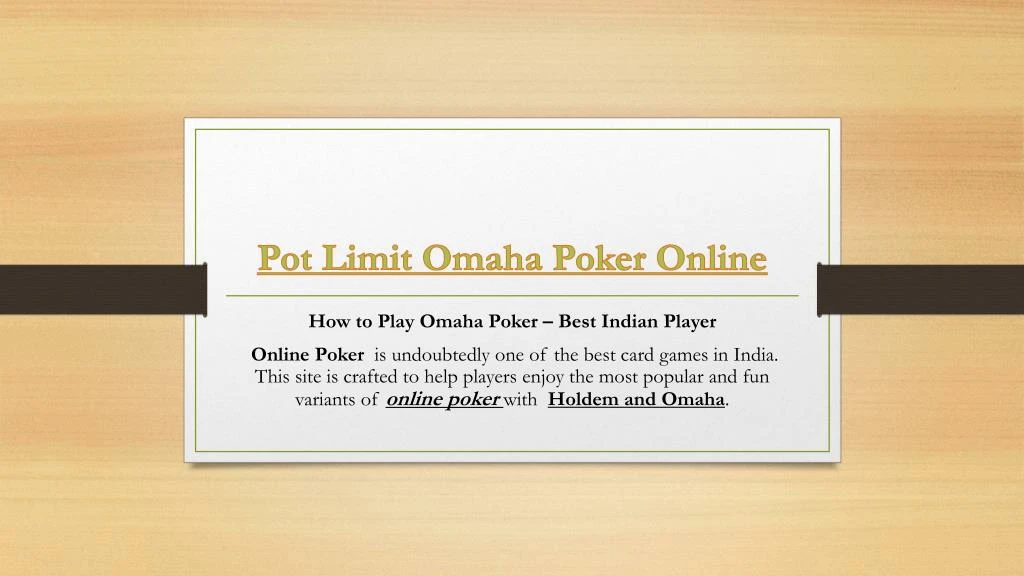Omaha Hi Lo (also known as Omaha 8 or Omaha Eight or Better) is a “split pot” version of the popular Omaha poker game. In this version of the game, there are two winning hands in each round: the high winner and the low winner.
Omaha hold'em, often called simply Omaha, is an exciting poker game that is strikingly similar to Texas hold'em, although it does have a number of differences to set it apart. Unlike Texas hold. Omaha hold 'em derives its name from two types of games. In the original Omaha poker game, players were only dealt two hole cards and had to use both to make a hand combined with community cards. This version of Omaha is defined in the glossary of Super/System (under Omaha) as being interchangeable with 'Tight hold 'em'.Across all the variations of the game, the requirement of using.
The high hand winner is the player with the highest value winning hand – the same as in the standard version of Omaha. The low hand winner is the player with the best hand featuring five unpaired cards valued 8 or lower. Flushes and straights are ignored in the low hand. If you know the basics of Pot Limit Omaha Hi strategy, you should have no problems getting to grips with Omaha Hi Lo strategy, so here are some tips to get you started.
Be prepared to fold on the flop
An essential Omaha 8 strategy is to recognize when you have a weak hand early on and get out quickly. The game favors the highest value hands so if the flop offers you little, it’s time to fold. Betting on average hands is a flawed Omaha Eight or Better strategy that will quickly end your game.
Forget about bluffing
If you are planning on bringing your Texas Hold’em bluffing skills to the Omaha Hi Lo table, think again. The game is driven by strong hands so when the betting starts, the chances are you are going up against players with high-value combinations. Bluffing in this situation is a sure-fire way to get beat. There are some Omaha Hi Lo strategy advanced situations where bluffing may be useful, but it takes time and experience to understand such nuances of the game. Until you reach that point, bet the hand you have.

Don’t commit too early
If you are dealt a strong early hand such as A-A-2-3 double-suited, don’t be tempted to raise early. You will reduce the field while committing a lot of money before you have seen the flop. It’s much better to keep as many players in the game as possible if you have the potential to hit the “nuts”. Some players may raise early if they have a good but not strong hand to try and force other players to fold but this strategy can backfire after the flop.
Remember, the key decision you need make after being dealt with your hole cards is whether to play your hand or not. If you have a premium hand, you should play but avoid raising until after the flop when there is a multi-way pot there to be scooped.
Omaha Hi Lo 8b Strategy
- How To Play Omaha Hi-Lo Split 8-or Better — Clear And Concise Guide – The Rules Of How To Play Omaha Hi-Lo.
- Omaha Hi-Lo Starting Hands Guide — Starting Hands Guide For Omaha Hi-Lo 8 or Better and PLO8
- PLO8 Poker – Ace-Two Errors & How To Spot Them — Every PLO8 Player Enjoys The Sight Of A2 As Part Of Their Starting Hand, However There Are Times When A2 Errors Can End Up Costing You Chips.
- Omaha Hi-Lo Point Count Systems For Starting Hand Selection — Dr Hutchinson’s Omaha Hi-Lo Point Count System Reviewed – Useful For Online Play??
- High Only Hands In PLO8 Poker – For The 30% Of The Time A Low Is Not Made, An Introduction To Profitable High-Hand Play.
- How To Avoid Being Quartered In O8 Poker – Avoiding Being Quartered In Certain Situations Can Make A Big Difference To Your Bankroll.
- Playing Static Flops In PLO8 – Cardrunners Coach Dan ‘CampFireWest’ Deppen takes us though some advanced strategy ideas.
- Omaha Hi-Lo Probability Math – How Often Will You Make A Low? — How Often Will You Make A Low For Different Starting Hands.
- All-Ins Pre-Flop In No Limit Omaha Hi-Lo — No-Limit Omaha Hi-Lo Strategy Should Include Defense Against The Constant All-In Overbets Pre Flop in NL08.
- Straights In Omaha Hi-Lo, A Closer Look! — Straights, Draws To Straights and When To Play Straights In Omaha Hi-Lo… A Closer Look!
- Omaha Hi-Lo Probability Math – How Often Will You Make A Low? — How Often Will You Make A Low For Different Starting Hands.
- Scooping PLO Hi-Lo Pots – The Why And The How! — Lets take a look at taking the high and low splits of the pot in O8 games.
The Hutchison Point System for Texas Holdem is an excellent beginners guide to starting hand selection. While learning this system will not make you a favorite at next year's World Series of Poker, it will most definitely give the new Texas Holdem player an idea of the value of the pocket cards he or she is holding.
Why is this important? The main reason players lose money in poker is because they play too many cards. This system limits the number of starting hands to cards that have a much better than average chance of winning. While this guide will not help you with many aspects of Holdem, including flop, turn and river play, it will simplify the process of which cards to hang onto and which to dump before the flop. This, in my opinion is the biggest challenge for players new to the game, and thusly a good edition for the general strategy section.
The Hutchison Point System
After being dealt your pocket pairs, assign the following values:
Ace = 16 points
King = 14 points
Queen = 13 points
Jack = 12 points

Ten = 11 points
All other cards are worth their “face value.” (ie. 5 of hearts is worth 5 points, etc)

Additional Qualifiers:
Pocket Pair = +10
Same Suit = +4
Connected = +3 (ie. 9-10, or Jack-Queen. No gaps.)
One Card Gap = +2 (ie. Jack-King)
Two Card Gap = +1 (ie. Jack-Ace)
What the numbers mean:
If your total is:
30+ Premium cards, that can be played from any position, if there are no raises.
27+ These cards can be played from Middle or Late position, provided there are no raises.
25+ Should only be played from late position, if there have been no raises.
To raise or call a raise, you should have a point total of:

34+ In early position
31+ In middle position
29+ In late position
Examples
Ace-Ace: That would be 16+16 for the two aces, and an additional +10 for their being a pocket pair. Thats a total of 42 points. Obviously strong and playable!

Queen-Jack suited: 13 + 12 for the cards, +4 for suited, +3 since they are connected. A total of 32. You could call the big blind with this hand in any position, but if there is a raise, you should only call the raise in middle or late position.
10-6 suited: 11 + 9 for the cards, +4 suited = 24 points. Fold them! This is a perfect example of a hand that many beginning players will call with, hoping for a flush or miracle straight draw. They will almost always lose, and even when the straight or flush is made, there is good chance that a higher straight or flush will take the pot.
Hutchison Statistics
Omaha Poker Strategy
The creator of this formula states that in simulations, only playing 30 point hands yielded a win rate of 17% in a 10 handed game where every hand is played to the river. Obviously, if you played every random hand, you would have an average win rate of only 10%. Thats a 70% increase.
Omaha Poker Point System Chart
In conclusion, one should note that the game of Texas Holdem is extremely complex, and a simple formula such as this certainly does not do justice to all of the other variables that determine winning and losing players. But even given the complexity of the game, it cannot be emphasized enough that the #1 mistake that beginners make is playing too many hands. If you have only lost money so far in Holdem, this is almost certainly at the root of the problem!
Omaha Poker Point System Rankings
The Hutchison Point System makes starting hand choices much easier to decide upon and should result in a much healthier bank roll for the beginner in low limit holdem.
For the full article and disclaimers by Edward Hutchison, click the following link:
